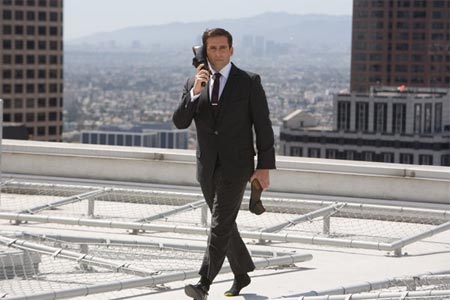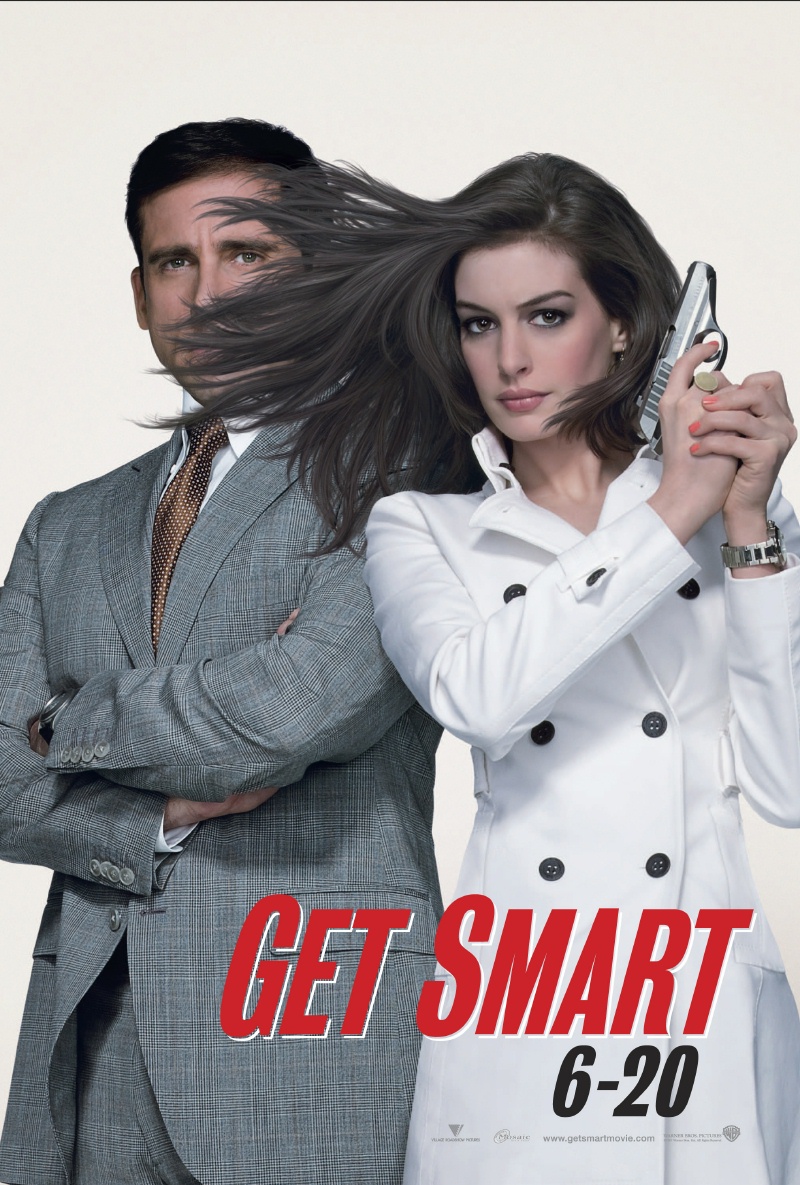This comedy does not need to “Get Smart;” it issmart. The screenplay takes the familiar gags from the ’60s sci-fi spoof (the cone of silence, the shoe phone, Hymie, etc.) but instead of trotting them out and expecting us to laugh merely because we recognize them (think THE FLINTSTONES), writers Tom J. Astle and Matt Ember update and re-imagine the old jokes in a way that is fresh and new, creating an updated version of the material that stands on its own as a hip, contemporary comedy, not a lifeless museum piece recreation. (One of the film’s more sly gags is that CONTROL is now located behind the facade of a museum.)
Equally important, director Peter Segal – along with an assist from the cast and crew, of course – understands that the word “comedy” is a license to laugh, not a license to slack off. Unlike the recent genre of spoof movies (SUPERHERO MOVIE, EPIC MOVIE, etc), in which the alleged parody is merely a ruse to create a second-rate rip-off, GET SMART is funny because it does not go for cheap laughs based on intentionally inept film-making. The sets, the action, the special effects, and the performances are as good as the real thing; you watch the film, realizing the people involved are playing for laughs because it is what they do well, not because they do not have the skills to play it straight.
The original GET SMART, created during the heyday of televised espionage, was very much of its era. Not only was it a take-off of its more serious predecessors; it was a satire on the Cold War outlook that divided the world between diametrically opposed systems of Good and Evil. Even the names of the show’s rival organizations, Control and Chaos, were so abstract as to invite laughter – an invitation that was signed, sealed, and delivered when Maxwell Smart undermined the lofty distinctions by referring to his side of the equation in scaled down, simple-minded TV terminology as the “forces of Goodness and Niceness.”
Well, those days are long gone, and the new GET SMART avoids the problem that plagued THE NUDE BOMB, the 1980 feature film that barely bothered to remove the mothballs before throwing the franchise up on the big screen. Realizing that the cultural context has changed and that riffing on old spy movie cliches is not enough to fill out a movie, GET SMART performs a clever piece of cinematic jujitsu, turning weakness into strength: instead of being an outdated relic; it is about an outdated relic.
At the beginning, Control is presented as something of an outdated dinosaur. The familiar icons (the car, the shoe phone, the suit) are on display in a museum, and the agency seems barely relevant to the current geo-political situation – until the plot contrives to give them a mission where they can once again excel and save the world.
Leading this revival is Maxwell Smart (Steve Carrell), who has been reinvented for the 21st century. No longer the American equivalent of Inspector Clouseau (i.e., a bumbler who luckily gets results), the new Agent 86 is an expert analyst whose interminably detailed reports of intercepted communications run to hundreds of pages that no one wants to read – even though they do contain vital information that others overlook. The film provides a clever visual contrast between Max and a more traditional image of a supercool superspy, in the form of Agent 23 (Dwayne Johnson), who has all the charisma, smooth moves, and experience that Agent 86 lacks.
Max wants to get out of the office and into the field, shoulder to shoulder with Agent 23, but the Chief (Alan Arkin) cannot afford to lose his best analyst; only when Control’s other agents have been compromised does Max get his chance. The ensuing hilarity derives not from incompetence on Max’s part but inexperience, making it easy to laugh without wincing. It also creates an interesting dynamic with the more seasoned Agent 99 (Anne Hathaway), who looks down on – instead of up to – her new male partner.
The story’s slightly subversive agenda is to turn Max into the real hero at the expense of Agent 23, suggesting that old fashioned Cold Warriors need to make way for a new breed of nerdy hero who thinks first and shoots later, if at all. Max even mouths a few vaguely liberal sentiments, suggesting that our enemies are people too, and understanding them as human beings can lead to victory.
Max gets to put his theory into practise when he encounters Dalip (Dalip Singh), who serves as the film’s equivalent of Jaws (Richard Kiel) in MOONRAKER – a point emphasized by spinning a variation on that film’s memorable pre-credits sequence, which featured James Bond falling from an airplane without a parachute and stealing one from an enemy agent during free-fall. Like Jaws, Dalip survives the ensuing fall, then proceeds more or less to follow in the footsteps of his cinematic predecessor: Max is able to – if not form an alliance – at least open up a line of communication by sympathizing with his erstwhile enemy, eventually leading to a hilarious payoff regarding the criminal mastermind pulling Dalip’s strings (Terence Stamp).
With a deft, deadpan aplomb worthy of the stone-faced silent movie comedian Buster Keaton, Carrell proves his character’s metal under fire, delivering laughs without ever seem to reach for them. (The film even throws in a droll set piece on the dance floor just to let both the actor and the character show off a little: you expect them to fall on their face for a cheap chuckle; you wind up laughing out loud because they do so well.) Carrell also lends a self-awareness to the character, who delivers his “Would you believe…?” routine like an intentional joke, not a bluff that was called. Even if you are not a fan of his previous work (THE OFFICE, EVAN ALMIGHTY), you will have to admit that he was the perfect choice for the role.
Hathaway, (perhaps best known for her Plain-Jane role in THE DEVIL WEARS PRADA, effortlessly transforms into a seductive secret agent, who is more than good enough to rank beside the best Bond girls. Alan Arkin gets lots more to do as the Chief than Edward Platt ever did, reminding you of why Hollywood should use him more often. Terence Stamp plays it relatively straight as the villain – part of the film’s effective strategy for avoiding camp. James Caan and Bill Murray show up for amusing cameos. Patrick Warburton, as Hymie, arrives just in time to make you eagerly anticipate seeing more of him in a sequel. Special credit goes to Dwayne Johnson, who has changed his professional name from “The Rock,” apparently because he wants to be taken seriously as an actor, not a former wrestler. As much as this ambition may tempt you to smirk, you have to admit that guy is pretty good: he is not just a stone-faced action hulk; he is an effortlessly funny character actor.
Toward the end of the film, backed into a corner and with resources thin, Max resorts to retrieving the old Control equipment from the museum display; unfortunately, not everything is in perfect working order. Thus, the film offers a nice nod to its source material without sinking into a sea of nostalgia – and scores a few effective gags as well. (When Max delivers his “Old shoe phone…” routine, he really is, for once, talking about an old trick we have seen before.) This playful relationship with the old GET SMART is the perfect approach for rehabilitating an old franchise: you get to poke fun without deconstructing the material entirely; you get laughs without the film itself becoming the butt of the joke. (Composer Trevor Rabin, former guitarist for Yes, also spins a few affectionate variations on the show’s familiar theme music.)
The track record of old TV series turned into films is littered with failures (even the box office successes have mostly been junk), but GET SMART proves that it can be done right. Best of all, it works better than many serious spy films – if you want action and intrigue that do not insult your intelligence, you would be better off watching this than either of the MISSION IMPOSSIBLE sequels.

GET SMART (2008). Directed by Peter Segal. Screenplay by Tom J. Astle & Matt Ember, based on the television show created by Mel Brooks and Buck Henry. Cast: Steve Carrell, Anne Hathaway, Dwayne Johnson, Alan Arkin, Terence Stamp, Terry Crews, David Koechner, James Caan, Bill Murray, Patrick Warburton, Masi Oka, Nate Torrence, Lloyd, Ken Davitian, David S. Lee, Dalip Singh.

7 Replies to “Get Smart (2008) – Film Review”